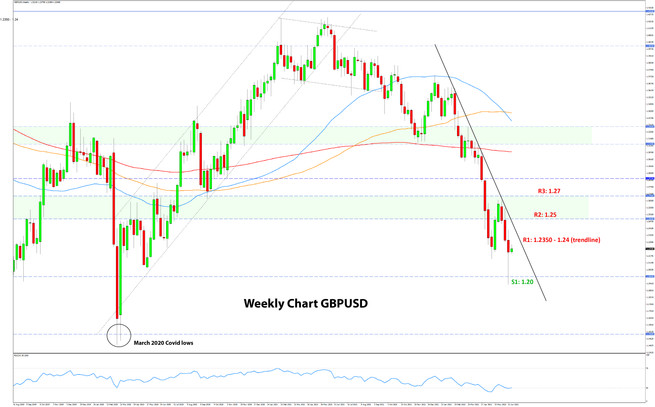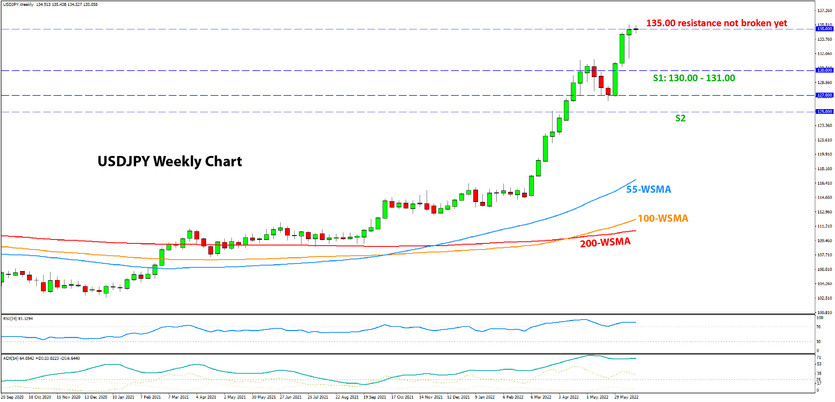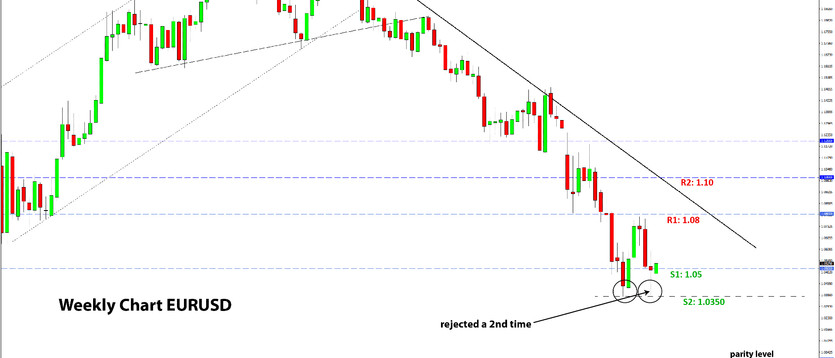USD Weekly Fundamental Outlook: Fed Turns More Forcefully Hawkish, Dollar to Stay Bid
Central banks ruffled up the markets last week, with the Fed, ECB, and SNB all delivering major surprise decisions. Naturally, this spurred wild swings across the Forex and other markets. As usual. the US dollar was at the center of the action, though the largest surprise was perhaps from the Swiss central bank (SNB), which shocked everyone with a 50bp rate hike. The Swiss franc strengthened sharply after their announcement.
In the US, the Fed also delivered a surprise of a larger 75 bp hike (50bp was expected). This was interpreted as an attempt for the FOMC to show its seriousness in fighting inflation. The forward guidance in the dot plot and communication by Powell during the press conference suggest that even the risk of a recession will not deter them from its hawkish trajectory. Inflation is now enemy no. 1, and the Fed will do everything to bring it down to the 2% target.
Aside from the wild gyrations and dollar correction last week, the long-term bullish factors for the US dollar remain largely unchanged. The US economy is (still) in an advantageous position compared to others (especially Europe) which will allow the Fed to be and probably stay more hawkish than the ECB and others this year. Furthermore, Fed tightening is bad for risk-sensitive assets, increasing the odds that we will see more risk-off episodes across different markets. This slight risk-averse tone in the markets can provide an additional boost to the safe-haven dollar. Thus, the USD stands to benefit from two factors this year - via the yield differential channel (higher rates than others) and via the safe-haven channel in times of falling stock markets.
The calendar is relatively light this week. Today (Mon) is a holiday, and the rest is mostly filled with 2nd tier data like housing and consumer sentiment reports. The markets will instead likely place more attention on scheduled Fed speakers. Of those, Chair Powell’s two-day testimony before Congress on Wednesday and Thursday is the main event.
EUR Weekly Fundamental Outlook: ECB Emergency Meeting Helps to Calm Italian and Greek Bond Markets
The ECB held an emergency policy meeting only one week after their regular meeting, which is very uncommon. Yet, they didn’t announce anything big, other than plans to deal with fragmentation risks (i.e. borrowing costs rising much faster for Italy than for Germany). Nonetheless, even this announcement that they plan to do something seems to have done the trick (for now), and Italian and Greek bond markets calmed down. This seems to have also helped the euro and kept it inside the consolidation versus the dollar.
Still, prospects that EUR strength can last remain grim at best. Yes, the ECB can artificially bring stability in Italian and Greek bond markets, but that will be done via QE purchases. This could have the effect of negating their planned rate hikes (to begin in July). Thus, the EUR will not be able to benefit from the ECB’s rate hikes to the same degree as other currencies can from their central bank’s tightening. This dynamic will likely leave the euro vulnerable to prolonged weakness during the summer months, perhaps even longer.
The EUR economic calendar features flash manufacturing and services PMI data (Thur) and the German Io business climate index. Negative surprises in those could exert renewed bearish pressures on the EUR currency. Markets will also continue to monitor ECB communication, with several ECB speakers scheduled this week, including speeches by President Lagarde and Chief Economist Lane.
EURUSD Technical Analysis:
EURUSD closed the past week with a high wave candle, indicating market indecision at the current juncture. Interestingly, the close was above the 1.05 level, while the weekly low was at the 1.0350 support zone. Based on this, we can say that the 1.0350 support zone has been solidified, which suggests a potential for the consolidation that started in early May (previous low) to be prolonged for a while more.
That being said, the powerful bearish momentum has hardly been challenged at all. EURUSD remains inside the strong downtrend, with strong resistance zones at 1.08 and 1.10 keeping the trend intact. If the consolidation is prolonged, any rally will likely have a hard time breaking through either 1.08 or 1.10.
On the other hand, a break below the 1.0350 low in the near term would signal the trend is ready to continue without a lengthier consolidation. In this case, all focus will shift to the parity zone (1.00) as the next important support for EURUSD.
GBP Weekly Fundamental Outlook: Bank of England Hikes by 25bp; CPI Inflation In Focus This Week
The Bank of England hiked rates by 25bp Thursday, which was largely expected and priced in. But the forward guidance was more hawkish than expected, and GBP reacted strongly around the event. The currency rose before, then fell on the announcement and then rose again a few hours later, each time erasing the previous move with a larger one. In the end, GBPUSD rebounded in tandem with other pairs on the brief USD correction.
But, despite the wild moves last week, the long-term dynamics remain unchanged here as well. That means that GBP remains vulnerable to more weakness, with the main factor weighing being the weakening economy. The toxic cocktail of high inflation and low growth will continue to pressure the currency. Perhaps one aspect that could slow GBP’s losses from here is the fact that the currency has already fallen a lot and is quite oversold. The scope for more steep losses is certainly smaller compared to 2-3 months ago when GBPUSD was still trading above 1.30.
The focus on this week’s calendar is on the CPI inflation report (Tue) and retail sales (Fri). Traders will also watch the flash manufacturing and services PMI reports.
GBPUSD Technical Analysis:
GBPUSD extended the bearish trend and already reached the big 1.20 area last week. Unsurprisingly, strong support emerged there, and GBPUSD rebounded rather quickly, finishing the weekly close some 270 pips off the lows.
The high wave candle on the weekly chart confirms that there are notable buying pressures here. However, it is not a bullish reversal signal by itself; hence this is not a sign of a bottom yet. Furthermore, GBPUSD remains in a downtrend, with trendline resistance located at 1.2350 - 1.24. Thus, GBPUSD bulls will have to wait for a more convincing signal of a bottom before calling a turn here.
To the downside, 1.20 is now also the nearest support in addition to being a crucial long-term technical area.

JPY Weekly Fundamental Outlook: BOJ Remains the Lonesome Dove; JPY Weakness to Extend
The Bank of Japan kept its dovish policies fully unchanged, disappointing JPY bulls (if there are any). They will continue to pursue the 10-year Japanese Government bond yield to stay below 0.25%, as defined by the YCC policy.
This was expected as BOJ Governor Kuroda has firmly suggested in all recent communication they have no intention of abandoning the YCC and QE dovish policies for now. The odds for intervention are probably slightly lower now too, which means the yen could weaken further in the near term. We could soon see USDJPY trading above 135.00, in which case a steep rise to 140.00 is not hard to imagine.
However, intervention still remains the main risk for short JPY trades, and such a sharp decline could actually trigger it. The other is a sudden change of policy at the BOJ if they abandon the dovish policies. The risks are growing that something will have to give, which could cause big outsized moves across JPY pairs. JPY traders need to be extra careful here as even placing stop losses may not help as expected if market conditions turn extreme.
USDJPY Technical Analysis:
USDJPY recorded another strong weekly close, even if not much above the previous week’s high. The retracement down to 131.50 was brief and quickly rejected, forming a long lower shadow (wick) on the weekly candle. This indicates that the bulls are still in control of this market, though it does not mean that upside continuation is immediate or likely.
For USDJPY bulls to get a bullish trend continuation signal, we need to see a move above last week’s high of 135.50. Hence, the 135.00 resistance zone hasn’t been broken yet. Above it, there is not much resistance left. The historically important zones are 140.00 and 145.00, and that’s what USDJPY traders will watch for resistance.
To the downside, the 130.00 131.00 zone is the first important support. A break below it would signal that a deeper retracement has likely started.






